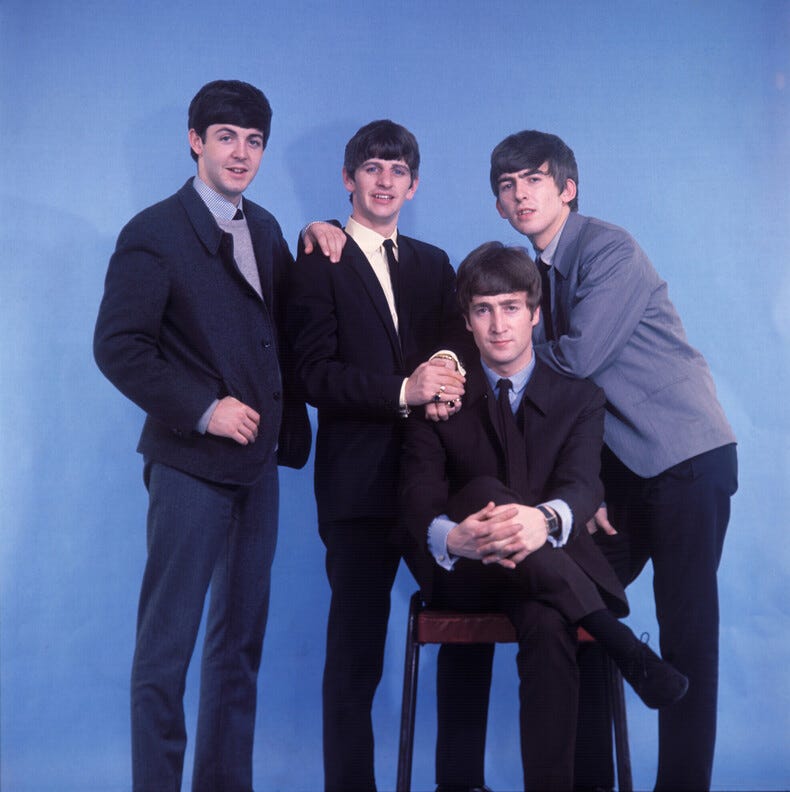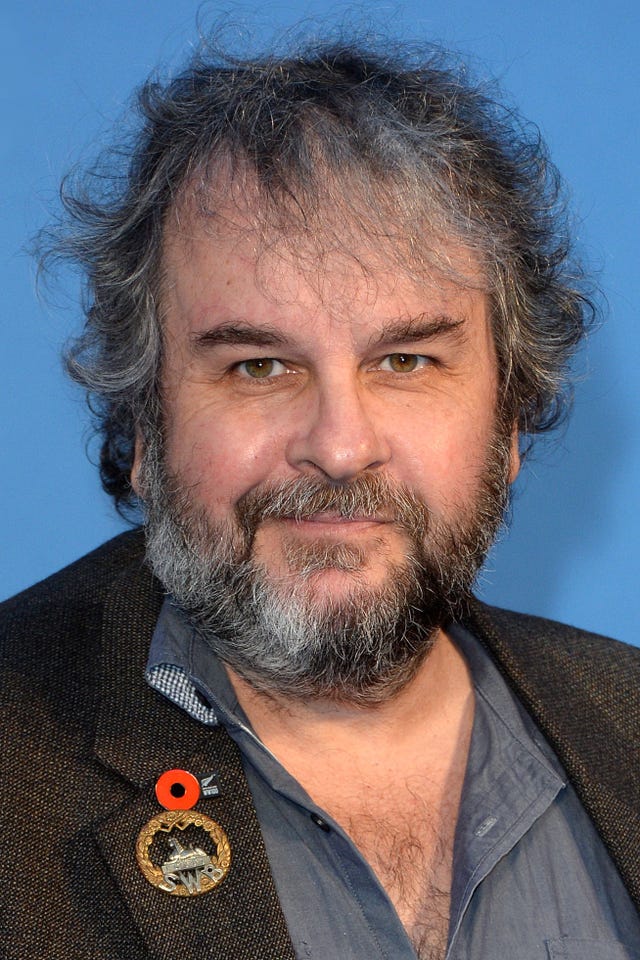“It’s a significant moment for the entire world when the Beatles have a new song,” so says one of the Fab Four’s biggest fans—a man who just happens to also be one of Hollywood's most beloved directors. Peter Jackson was a precocious teenager when he first came across the Red and Blue compilations in a record store in his New Zealand hometown, buying them with the cash he originally intended to spend on model airplanes.
It kicked off a musical obsession that has, now 50 years later, bled over into his professional lore. On the heels of directing the acclaimed 2021 documentary series The Beatles: Get Back, which chronicles the making of Let It Be and the band's famed final rooftop concert, Jackson now has the distinction of directing a retrospective music video for what’s being billed as the last ever Beatles song: the ruminative “Now and Then.”
Jackson and his team have pioneered an audio technology that has not only enabled fresh remixes of the Beatles’ most indelible hits, but also helped resurrect “Now and Then” by taking a noisy demo recorded by John Lennon and turning it into a crisp, new release. In an exclusive interview, Esquire spoke to Jackson about teaming up with his heroes, his fear of music videos, and where he and the Beatles go from here. This conversation has been edited for clarity and length.
Esquire: You've taken two of your biggest personal passions and made them professional projects. What was the bigger task: doing right by Tolkein, or doing right by the Beatles?
Peter Jackson: [Laughs] I may have to dodge that question. It’s impossible to answer. But I will tell you something that I haven’t really talked about. You’re only the second person I’ve spoken to about this. Apple Corps called me and said, “Oh, Peter, would you be interested in doing the official video for the song, ‘Now and Then?’” Over the years, I’ve been asked to do music videos a few times. Not very often, but a few random bands have asked me. But I’m absolutely intimidated by it. I’m not intimidated by making a three-hour visual effects film, but I never think that my brain is wired to understand a four-minute music thing.
Martin Scorsese recently said that it’s harder to work on something condensed because every frame counts. I’m assuming you can relate?
I see music videos that are absolutely brilliant, and I just think I could never do it. My head doesn’t work that way. So, the Beatles are now asking if I could do it for their final song? So I said no. I turned them down. And I turned them down mainly because I was really, really nervous and insecure.
When it came to directing the Get Back docuseries, you have said there wasn’t a chance in a million years you’d say no to that. Wasn’t that also a completely different undertaking from the bulk of your career?
Documentaries I’ve done in the past and in my head. When it comes to music videos, I’m totally insecure. A lot of it was fear too; if the first music video I’ve ever made in my life will be the Beatles final song. You do that badly and it’ll just be an awful thing, so I’d rather they’d go to someone else who does a great video and I’ll just enjoy it.
What made you change your mind?
In January, I got another call from Apple and they said, “Peter, we’ve tried to find a filmmaker to do the video for us but we can’t find anyone we’re happy with.” And the boys, or “the Fabs,” as they call them, “They’ve asked to go back to you and really beg you to do it.” I was just as intimidated then as I was the first time around, but now I felt like I was being pushed into a corner and I couldn’t say no. Fortunately, the editor Jabez Olssen, who I cut Get Back with, has a lot more confidence in music videos than me and he’s done some in the past. So I relied on him and said “What can we do here?” Shot by shot we pieced it together.
Can you take me through that process? How’d you hit the ground running?
Paul and Ringo went into their studios and they filmed themselves playing the drums and bass. Paul shot his on an iPad. They sent it back to me in New Zealand and I said to Apple, “When the three Beatles—George, Paul, and Ringo—got together in 1995 to work on demos, was their work on ‘Now and Then’ filmed?” And they said, “No, we’ve only got an hour of film from the ’95 sessions.” But when I saw the hour of footage they sent me, George Harrison wears four different shirts. So I said, “So, if the film crew only went in for an hour to shoot this footage, why is George wearing four different shirts? Could it be four different days?” They phoned me up and said “Guess what, we’ve found more of the ’95 footage. We have 14 hours.” That arrived and we went through it all and sure enough, they're working on “Now and Then” for two-and-a-half, three hours on camera.
So from that visual foundation, how did you go about crafting the rest?
When I first saw an original cut, it was feeling sentimental and depressing. It’s easy to make people feel sad because two of the Beatles are gone and this is the last song. But the Beatles were also humans who took the piss out of people. They did not like people who treated them too seriously and they didn’t treat themselves too seriously, they had so much humour. So I thought it could be sentimental and sad at the beginning and the end, but in the middle we have to make it funny. But how the hell do you make it funny? So, we pieced together where we have Ringo and Paul in 2023 trying to work on a song and they get invaded by the 1967 Beatles. So that was the idea, that they show up to disrupt them as they attempt to finish the song.
It’s a frequent thing that people say, “If I only had a time machine, I’d see the Beatles on Ed Sullivan or at Shea or the rooftop concert.” But this video feels like that time machine. You’re acknowledging the present and the past, all in one tidy package.
I had this idea to end on a montage that reminds people of the enormity of the Beatles, and this concept of going backwards came about, from the ’60s into the ’50s and then into childhood. We asked Sean [Lennon] and Olivia [Harrison], as well as Paul and Ringo to dig up childhood photos. I didn’t want photos that everyone had seen before, I wanted to get something new. People don’t know this, but the video contains the first-ever film ever shot of the Beatles, the only film from the Hamburg jackets that was shot. It was about 40 seconds of it and we managed to get the rights. That’s completely unseen footage.
How did you hear that that existed?
I heard rumours that it existed, and Apple said, “Oh yeah it’s true, but there’s a problem.” They said, “It’s an 8mm film and it’s owned by Peter Best,” the band's old drummer [who was later replaced by Ringo Starr]. So Clare Olssen, who produced the video, bravely got on the phone and contacted Peter Best to get a few seconds of his film. And to be honest, the Best family was incredibly kind in their support.
Throughout your career, you’ve been at the cutting edge of filmmaking technology, and now music technology. Why is innovation important to you?
Well for this, it was born of a problem we had. When we were working on Get Back, which took us four years to make, for the first three years I was putting it together and was excited to see the footage but I was so frustrated by the audio because it was so noisy. The performances were unmixed, and the Beatles were always so fussy about the final mixes and the quality. I just felt bad about it. I was worried that when people saw the documentary, they weren’t able to understand it. At some stage, we were planning on having subtitles for the majority of the doc. Then a breakthrough happened where we had somebody develop the idea of machine learning separation; we did tests and they were quite good. They did more tests, and it got better and better.
This technology stems from forensic investigation, right?
Yeah. Somebody told us that the New Zealand police have a piece of confidential law enforcement software that they use for surveillance. When it’s noisy and they want to hear a conversation between two crooks or something, they can isolate their voices. I thought that'd be incredible to use, but it’s not software that’s available to the public. So, we contacted the cops and we asked, “Do you mind if we brought some tape to the police station and we ran it through your confidential audio software?” And they said, “Sure, bring it down.” So, we did a 10- or 15-minute test and the results were really bad. I mean, they did the best they could. But you realize that for law enforcement, the quality and fidelity of the audio doesn’t need to be good, so it was far, far short of what we could use.
Our sound guys who went down there came back and said, “We know how they’re doing it and we can do it far, far better.” So, our guys sat down [and worked on] basically what they’d seen at the New Zealand police station, just the theory of it, and had a lot of work to do to make it high fidelity. But after a couple of months, they produced results that were really great. To hear some of those early songs in a fully dynamic way… You realize what you've been hearing is quite a limited range of audio. You don't realize how crude the mixing on some of the early songs were, how muddy they were.
How did that technology help bring “Now and Then” to life?
After we developed this software that could separate tracks, I got a call from Paul. He said, “We’ve got this other demo of John’s we’ve been wanting to finish for years, but it’s always been hard because the piano’s too loud, there’s a buzz on it.” He said, “We abandoned it, but I’m really keen to try to do it. Do you think the software you used for Get Back could help?” I said, “Yeah, of course!” Considering the complexity we did on Get Back, where we were separating Ringo’s drums, just to split John’s voice from the piano and the buzz is a fairly simple thing. So, I just said, “Yes, send it down and we’ll stick it through the software.” And when it showed up, we got a pretty clean track. We sent it back to Paul.
Two months went by, then in August or September of last year, they sent me the mix that Paul and Ringo had worked on with [producer] Giles Martin. So, I’ve had a weird experience where it’s felt like I've had a brand-new Beatles song all for me for an entire year. I've been playing it over and over for a year and no one else has heard it.
You refer to yourself as “not a music guy” frequently. So how did your Beatles fandom materialise?
I’m not a music guy in the sense I can’t play an instrument and I don’t think I’d be capable of it because my brain isn't wired for that. And I have no musical understanding: I don’t know chords, bars, notes. So that’s what I mean. But certainly, my love of the Beatles goes back to when I was 13 with the Red and Blue albums. [Laughs] I remember walking past the record store and those had just come out. I didn't intend to buy a record, I intended to buy a model plane after saving up some money, and I was on my way to the model plane shop, up the road. But there was a record shop which had a display of those albums, and I was captivated by the two covers—the young and the old. It immediately attracted my curiosity. I thought, “Maybe I'll buy the model plane another day.” I just had enough money to buy those two. And that’s what started my whole Beatles thing, so here we are in 2023 and we just helped them remaster the Red and the Blue. It feels good.
Will your Beatles work continue?
Well, I don’t know exactly what the Beatles’ plans are and I don’t want to ask them and be a fanboy. And this is a guess, but I’d imagine the Beatles and Giles would want to continue remixing all of the albums. I’m assuming we’ll continue to help with separation on them, but who knows what the Beatles future holds? I have no idea. But my experience with the Beatles has been an absolute pleasure. I’ve spent my career working with the studios and some are good and some aren’t that good; you meet good and bad people and you have pressures, the budget and people on your back all the time. But the experience working with the Beatles has been so relaxed, so much fun—because they work on their own stuff, there’s no third party involved.
Are you working on any traditional narrative features at the moment?
Well, I always am. Fran [Walsh], my partner, and I, we’re sort of teetering around with two or three scripts and things, but I don’t have another film set. But there’s never been a period where we're not working on a script or idea. We do different things when fate directs us to whatever one actually gets made. So, I don’t know what the Beatles future holds and we don’t know what the film future holds. I’m just doing what I normally do.
Rob LeDonne is a culture and humor writer whose work can be seen in Billboard, The New York Times, The Guardian, Vogue, Rolling Stone, and Interview. He also regularly writes about music for The Recording Academy.















